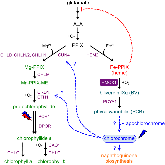Bilin-Dependent Photoacclimation in Chlamydomonas reinhardtii
- Department of Plant Biology, Carnegie Institution for Science, Stanford, California 94305, Department of Biology, Stanford University, Stanford, California 94305
- Department of Chemistry and Biochemistry, University of California, Los Angeles, California 90095, Institute for Genomics and Proteomics, University of California, Los Angeles, California 90095
- Department of Plant Biology, Carnegie Institution for Science, Stanford, California 94305
- Department of Molecular and Cellular Biology, University of California, Davis, California 95616
- College of Life Science and Technology, Huazhong Agricultural University, Wuhan 430070, China
- Department of Chemistry and Biochemistry, University of California, Los Angeles, California 90095
- Horticultural Sciences Department, University of Florida, Gainesville, Florida 32611
- Department of Molecular and Cellular Biology, University of California, Davis, California 95616, State Key Laboratory of Agricultural Microbiology, College of Life Science and Technology, Huazhong Agricultural University, Wuhan 430070, China
In land plants, linear tetrapyrrole (bilin)-based phytochrome photosensors optimize photosynthetic light capture by mediating massive reprogramming of gene expression. But, surprisingly, many green algal genomes lack phytochrome genes. Studies of the heme oxygenase mutant (hmox1) of the green alga Chlamydomonas reinhardtii suggest that bilin biosynthesis in plastids is essential for proper regulation of a nuclear gene network implicated in oxygen detoxification during dark-to-light transitions. hmox1 cannot grow photoautotrophically and photoacclimates poorly to increased illumination. We show that these phenotypes are due to reduced accumulation of photosystem I (PSI) reaction centers, the PSI electron acceptors 5'-monohydroxyphylloquinone and phylloquinone, and the loss of PSI and photosystem II antennae complexes during photoacclimation. The hmox1 mutant resembles chlorophyll biosynthesis mutants phenotypically, but can be rescued by exogenous biliverdin IXα, the bilin produced by HMOX1. This rescue is independent of photosynthesis and is strongly dependent on blue light. RNA-seq comparisons of hmox1, genetically complemented hmox1, and chemically rescued hmox1 reveal that tetrapyrrole biosynthesis and known photoreceptor and photosynthesis-related genes are not impacted in the hmox1 mutant at the transcript level. We propose that a bilin-based, blue-light-sensing system within plastids evolved together with a bilin-based retrograde signaling pathway to ensure that a robust photosynthetic apparatus is sustained in light-grown Chlamydomonas.
- Research Organization:
- Univ. of California, Los Angeles, CA (United States)
- Sponsoring Organization:
- USDOE Office of Science (SC), Basic Energy Sciences (BES)
- Grant/Contract Number:
- FD02-04ER15529; Program No. 2014RC018; FG02-04ER15529
- OSTI ID:
- 1405560
- Alternate ID(s):
- OSTI ID: 1511837
- Journal Information:
- The Plant Cell, Journal Name: The Plant Cell Vol. 29 Journal Issue: 11; ISSN 1040-4651
- Publisher:
- Oxford University PressCopyright Statement
- Country of Publication:
- United States
- Language:
- English
Web of Science
Similar Records
Elucidating the origins of phycocyanobilin biosynthesis and phycobiliproteins
Mg chelatase in chlorophyll synthesis and retrograde signaling in Chlamydomonas reinhardtii : CHLI2 cannot substitute for CHLI1




